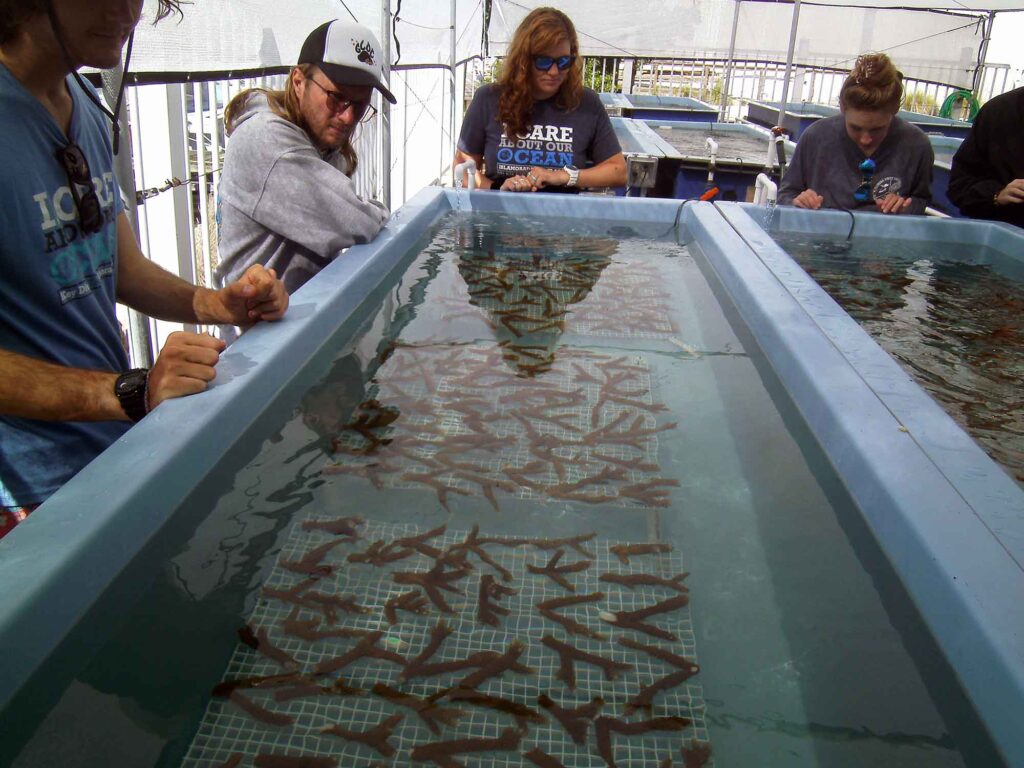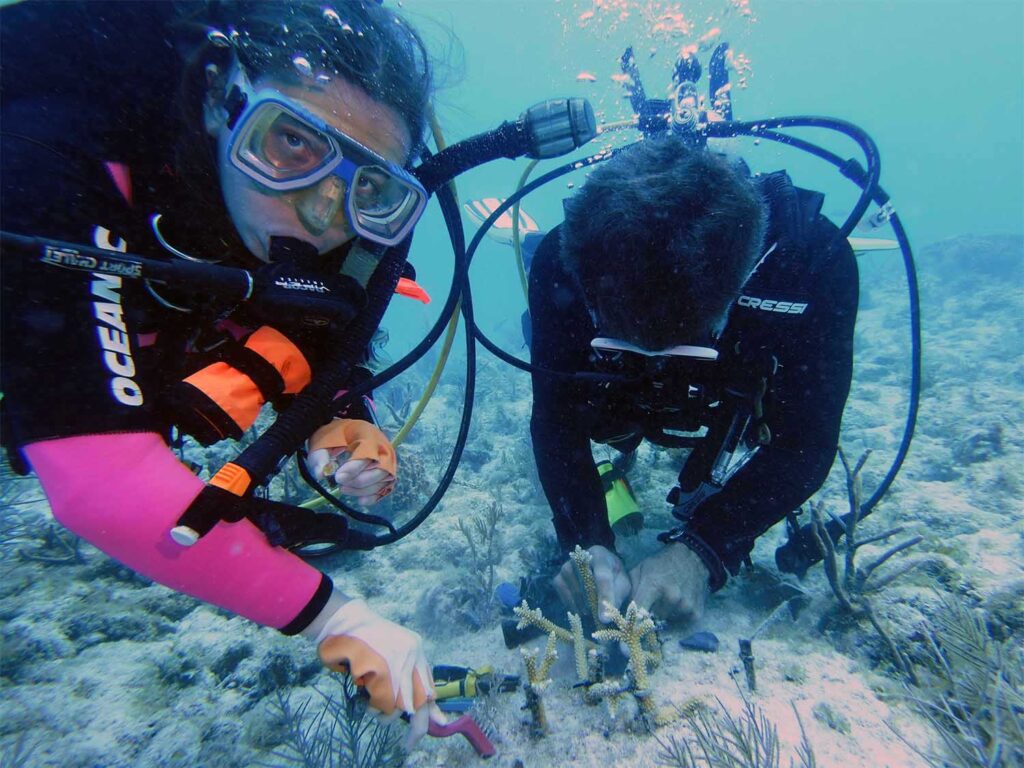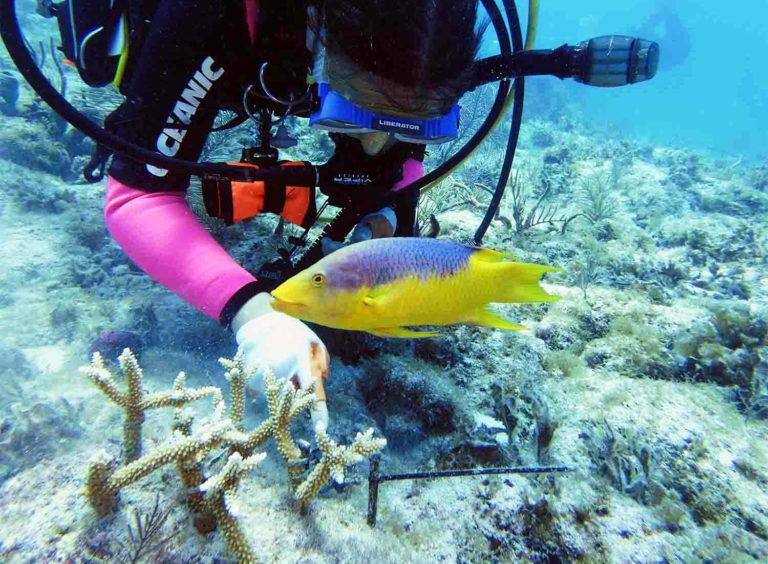A Florida fisherman spent seven decades taking from the sea – now he is committed to giving it back, and on a grand scale.
JOHN CHRISTOPHER FINE reports on a project in which volunteer scuba divers create coral reefs fit to face the future, and provides the photos.
Also read: Deep doodoo: Diver’s-eye view of a Florida problem
“Some study the ocean environment. I’m not that person – I utilise it,” says Richard Stanczyk. He sits at his desk in a room full of deep-sea fishing photographs. One remarkable picture shows him with his son Ricky and two gigantic swordfish aboard their boat.
“I’ve been fishing for 70 years,” he continues. “I’ve witnessed a lot of things that were not good. Algae attributed to big sewage. Living in this community, we’ve got to have sewers. It took 25 years to put them in. I’m a bone fisherman. The shallows where I fished were smothered by brown algae. This was caused by farming with agricultural run-off and acid rain.”
Richard has been monitoring the state of the ocean for many years, but his most recent observations are telling: “With Covid-19, no planes were flying. No one was here in the Florida Keys. The sky was clearer, whiter.”
Population explosion in the Keys and elsewhere in Florida has made the state the USA’s third most populous – and has also created havoc for a fragile environment based on sand and limestone. Anything that goes onto the land eventually works its way out into the bays and ocean. Evaporation causes chemicals and animal waste to return in the form of rain.
The elementary science has been ignored by government, and the many who deny human-caused environmental changes are helping to destroy ocean reefs.
Richard, his son and his customers at Bud ’n’ Mary’s Marina, which they have owned for 43 years, have caught and still catch fish. Some release them, others use them for food.
“There has been a reduction in fish stocks,” he observes. “Technology and long-lines…” He goes on to list the causes – factory ships and commercial ventures that take fish in nets, and widespread use of hooked lines many miles long that drift in the open ocean and catch fish indiscriminately.
“If you lose the habitat, you lose everything,” says Richard. “I used to catch swordfish. It didn’t take long for the long-liners to wipe them out. The Gulf Stream comes in here. It’s slowing down. Used to be we’d go out and we could hold the bottom with 15lb; now it only takes 5lb to anchor. Scientists are proving it. I saw it happening.
“That’s why I’ve donated use of land here for the coral-restoration project. No other way can I express my gratitude for a life I’ve lived on the ocean. Now I have four grandchildren. I want them to enjoy it.
“The coral they are growing here will be disease-resistant and withstand temperature changes. Scientists say it will grow 20 times quicker than natural coral, once planted in the ocean. It is marrying economy to the environment. Save the reef, save the economy.”
It’s a practical man’s commonsense approach to a grave problem that researchers describe in dire terms as the worldwide demise of coral reefs.
Astounding progress
It is not just in the Florida Keys that coral is dying off. The largest coral reef in the world, eastern Australia’s Great Barrier Reef, started life 20,000 years ago, runs some 1,600 miles and is dying. Hundreds of miles of reef have been destroyed by coral-bleaching.
Warm water, attributed in part to the El Niño effect between 2014 and 2017, saw 70% of coral reefs worldwide affected by bleaching. In the Indian Ocean, a 1998 bleaching incident took a toll on 80% of the coral population.
“In the Florida Keys, live coral coverage amounts to 3-5%,” says Dr Kylie Smith. “In the 1970s it was 70%.” Dr Smith works with Mote Marine Laboratory in Summerland Key and is co-founder of I.CARE (Islamorada Conservation & Restoration Education), an initiative developed by her and dive professional Mike Goldberg to grow disease- and temperature-resistant corals in laboratory conditions, then plant them in the ocean.

The programme began a year ago, and it has made astounding progress. It started by transporting corals from Mote’s main facility, about an hour south, to Islamorada, taking them out to permitted reef areas.
In co-operation with the National Oceanic & Atmospheric Administration (NOAA) and Marine Sanctuary authorities, divers use epoxy to cement the farm-raised coral to a substrate of dead coral. I.CARE then conducts regular monitoring and reporting on its growth and progress.
Coral is an animal that reproduces sexually as males and females release sperm and eggs into the water column. In some cases both sexes are contained in the same individual. Some coral species are asexual. These grow to a certain size then send off a bud, a clone of the original.
In some cases, storms cause breakages and a fragment of coral continues to grow in another area. Some coral-restoration projects are permitted to gather these broken coral fragments, and take them to coral plantations where they are hung on floaters, harvested when ready and replanted on substrate in the open ocean.
In the wild, coral larvae settle on a substrate and begin to grow. Zooxanthellae plants live symbiotically inside the coral polyp and help with the animal’s food supply. Like all plants, they require sunlight to penetrate for photosynthesis to produce oxygen and carbohydrates.
When ocean water is clouded for any period of time, the Zooxanthellae die and can no longer supply the coral with nutrients or help to remove waste. Without these plants, corals turn white. Often the bleaching is irreversible and the affected corals die.
Many events cause silt to cloud the water, including pollution, dredging for beach renourishment projects, algae growth and climate change. It doesn’t take much of a rise in water temperature to expel Zooxanthellae, which normally live in the 21-30°C range.
Increased ocean acidity resulting from high levels of acidic chemicals returning to Earth as rain affect coral’s calcium carbonate theca, in which live polyps grow.
Scientists predict that in a few years ocean acidity will be high enough to cause these limestone homes for coral to dissolve. Sediment, climate change and acidification, all the results of human activity, are affecting fringing reefs, patch reefs, atolls and barrier reefs.
So with problems on this global scale, can initiatives such as I.CARE restore coral growth in areas affected by bleaching and coral-wasting disease?
The coral nursery
Since the programme began in Islamorada, Mote has been able to establish a modern facility at Bud ‘n’ Mary’s Marina, thanks to the Stanczyk family providing valuable ocean-front land. Water is drawn from the sea into a large, insulated tank in which temperature, acidity and chemical content can be controlled.

The water is then pumped into what will eventually be the 20 tanks that contain the coral nursery. Corals are micro-harvested under licence from species that have survived bleaching and disease – these are resistant organisms already growing in the sort of ocean conditions that researchers predict will occur in the future. Once they reach an appropriate size, they are taken out to sea for planting.
In other coral-restoration projects some plantings have died, and in other cases have failed to reproduce. Humans can’t always solve the mysteries of nature, so will the re-planted corals reproduce?
“We are placing corals closer together and alternating genus nearby,” says Kelsey Sox, a fisheries biology graduate and I.CARE intern. “We think this will enable the corals to trigger release of sperm and eggs.” She and fellow intern Nathan Greenslit are monitoring the growth of a staghorn coral (Acropora cervicornis) planted about 6m deep on a reef called Rocky Top.
The area is littered with dead staghorn branches, and plateaus of dead hard coral are being used for the plantings. All the new plantings appear alive and healthy.
“In order for it to work, someone has to be there to do the labour,” says Mike Goldberg, who runs Key Dives in Islamorada. “The science behind it is astounding. What Mote has been doing is extraordinary.” He had arrived from the British Virgin Islands, where he had run a successful dive operation. Like Stanczyk, his experience is practical, in his case as underwater instructor and explorer.
“We needed a lot of space to create a coral nursery,” he says. “We were able to bring everyone together. With the great generosity of the Stanczyk family, that’s how the nursery here came to be.”
A secure future

We have become sorcerers’ apprentices on a massive scale. In a few short years, humans have destroyed what nature took eons to establish. Without healthy coral reefs, mother of the oceans, nursery and habitat for marine creatures, life will be gone.
Storms will break on the land and majestic underwater structures will disappear. Initiatives such as I.CARE offer great hope and opportunity for positive farming of the oceans.
The coral nursery, patterned after the main facility Mote operates on Summerland Key, is in place. Biologists and volunteer scuba divers are on hand to do the work; dive operators have committed to regular coral planting trips and, as Mike says: “We have a community that supports it. This creates a legacy for the Stanczyk family, a secure future for a healthier ocean. Richard’s grandchildren, all children, will be able to enjoy Islamorada’s coral reefs.”
“Sometimes you look at the gravity of a problem and can say: the heck with it,” says Richard Stanczyk. “Can’t do that with our reef environment. We have to start someplace. It’s a privilege at my age to be able to be part of it. I’m very proud of it.”

John Christopher Fine is a marine biologist and has dived shipwrecks all over the world. He is a Master Scuba Instructor, Instructor Trainer and the author of some 25 fiction and non-fiction books on a wide range of themes.
Also on Divernet: Sponges: Glue Of The Reef, Ten Ways Tech Is Rescuing Coral, A Dive Pioneer Turns 80 On Bonaire


do you have volunteer contact details for the coral growth scheme? Great article
Hi Stephen, thanks, and probably best to contact Alene Nelson at I.CARE – alene@icareaboutcoral.org
Very interesting project and worthwhile